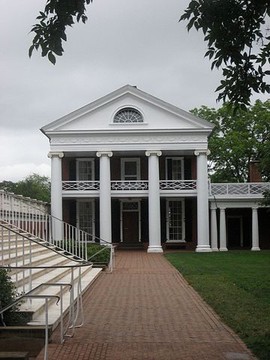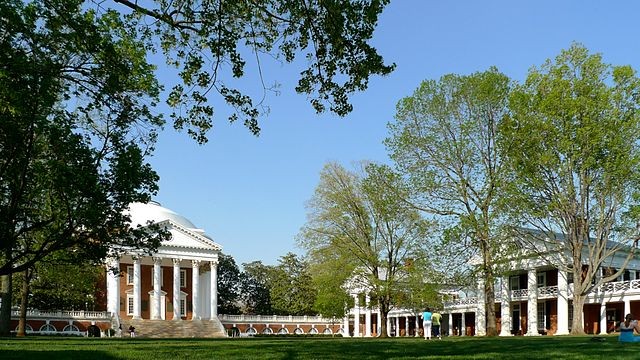Pavilion II
Introduction
Text-to-speech Audio
Pavilion II is a historical building located on the east side of the Lawn at the University of Virginia. It is situated directly across from Pavilion I at the base of the Rotunda steps. This structure was completed in October of 1822 and is styled after the Ionic order of the Roman Temple of Fortuna Virilis. In 1895, a bucket brigade saved Pavilion II from the fire that gutted the Rotunda.
Images
Pavilion II (center) and the stairs and columns of the Rotunda (left) in the Academical Village of the University of Virginia

The Lawn of the University of Virginia, USA, with the Rotunda (left) and Pavilions II (middle) and IV (right)

Backstory and Context
Text-to-speech Audio
The Pavilions are located along the east and west sides of the University of Virginia's Academical Village. Centered around the Lawn, the Academical Village was designed by Thomas Jefferson as a unique environment where scholars would live and study in an architecturally unified space. The ten pavilions each represent an academic discipline, an order of ancient architecture, and were intended to recognize the dignity of each subject.
Pavilion II was designed by Jefferson over the course of fifteen days in 1819. He was 76 at the time. The building was largely complete by 1821. Pavilion II draws upon the Ionic order of the Roman Temple of Fortuna Virilis, as depicted in Andrea Palladio’s Four Books of Architecture. The four, two-story Ionic columnns form three bays and are made of plastered brick. The capitals are carved from Italian Carrara marble. Pavilion II is the only pavilion in the Academical Village to feature a small ventry vestibule in front of the entryway.
There are a number of gardens located near U.Va's pavilions. The one at Pavilion II features plants that have both an ornamental and practical purpose. These include a large pecan tree planted by Dean Ivy F. Lewis, blueberry and grape vines, four heirloom varieties of plums, edible Daylilies, and crabapple trees.
Pavilion II was designed by Jefferson over the course of fifteen days in 1819. He was 76 at the time. The building was largely complete by 1821. Pavilion II draws upon the Ionic order of the Roman Temple of Fortuna Virilis, as depicted in Andrea Palladio’s Four Books of Architecture. The four, two-story Ionic columnns form three bays and are made of plastered brick. The capitals are carved from Italian Carrara marble. Pavilion II is the only pavilion in the Academical Village to feature a small ventry vestibule in front of the entryway.
There are a number of gardens located near U.Va's pavilions. The one at Pavilion II features plants that have both an ornamental and practical purpose. These include a large pecan tree planted by Dean Ivy F. Lewis, blueberry and grape vines, four heirloom varieties of plums, edible Daylilies, and crabapple trees.
Sources
Bergstrom, Briana. "A Deeper Look at what is Around You: Pavilion II." BioGrounds at the University of Virginia. Last modified May 13, 2015. http://biogrounds.org/2015/05/13/a-deeper-look-at-what-is-around-you-pavilion-ii/.
"The Lawn." Wikipedia, the Free Encyclopedia. Accessed March 23, 2017. http://en.wikipedia.org/wiki/The_Lawn.
Singleton, Maura. "At Home in History: Pavilion residents bring personal touches to revered buildings." University of Virginia Magazine, 2011. http://uvamagazine.org/articles/at_home_in_history/P2.
"U.Va. Web Map: Pavilion II." The University of Virginia. Accessed March 23, 2017. http://www.Virginia.edu/webmap/popPages/pavilion2.html.
"University of Virginia, Pavilion II, East Lawn, University of Virginia, Charlottesville, Charlottesville, VA." Library of Congress. Accessed March 23, 2017. http://www.loc.gov/pictures/item/va1201/.
Pavilion II and Rotunda; image by Timothy Jarrett - Flickr: Lawn photos, CC BY-SA 2.0, https://commons.wikimedia.org/w/index.php?curid=13271662.
Lawn of U.Va image by Daniel Latorre - Flickr: University of Virgina, CC BY 2.0, https://commons.wikimedia.org/w/index.php?curid=12882574.
"The Lawn." Wikipedia, the Free Encyclopedia. Accessed March 23, 2017. http://en.wikipedia.org/wiki/The_Lawn.
Singleton, Maura. "At Home in History: Pavilion residents bring personal touches to revered buildings." University of Virginia Magazine, 2011. http://uvamagazine.org/articles/at_home_in_history/P2.
"U.Va. Web Map: Pavilion II." The University of Virginia. Accessed March 23, 2017. http://www.Virginia.edu/webmap/popPages/pavilion2.html.
"University of Virginia, Pavilion II, East Lawn, University of Virginia, Charlottesville, Charlottesville, VA." Library of Congress. Accessed March 23, 2017. http://www.loc.gov/pictures/item/va1201/.
Pavilion II and Rotunda; image by Timothy Jarrett - Flickr: Lawn photos, CC BY-SA 2.0, https://commons.wikimedia.org/w/index.php?curid=13271662.
Lawn of U.Va image by Daniel Latorre - Flickr: University of Virgina, CC BY 2.0, https://commons.wikimedia.org/w/index.php?curid=12882574.
